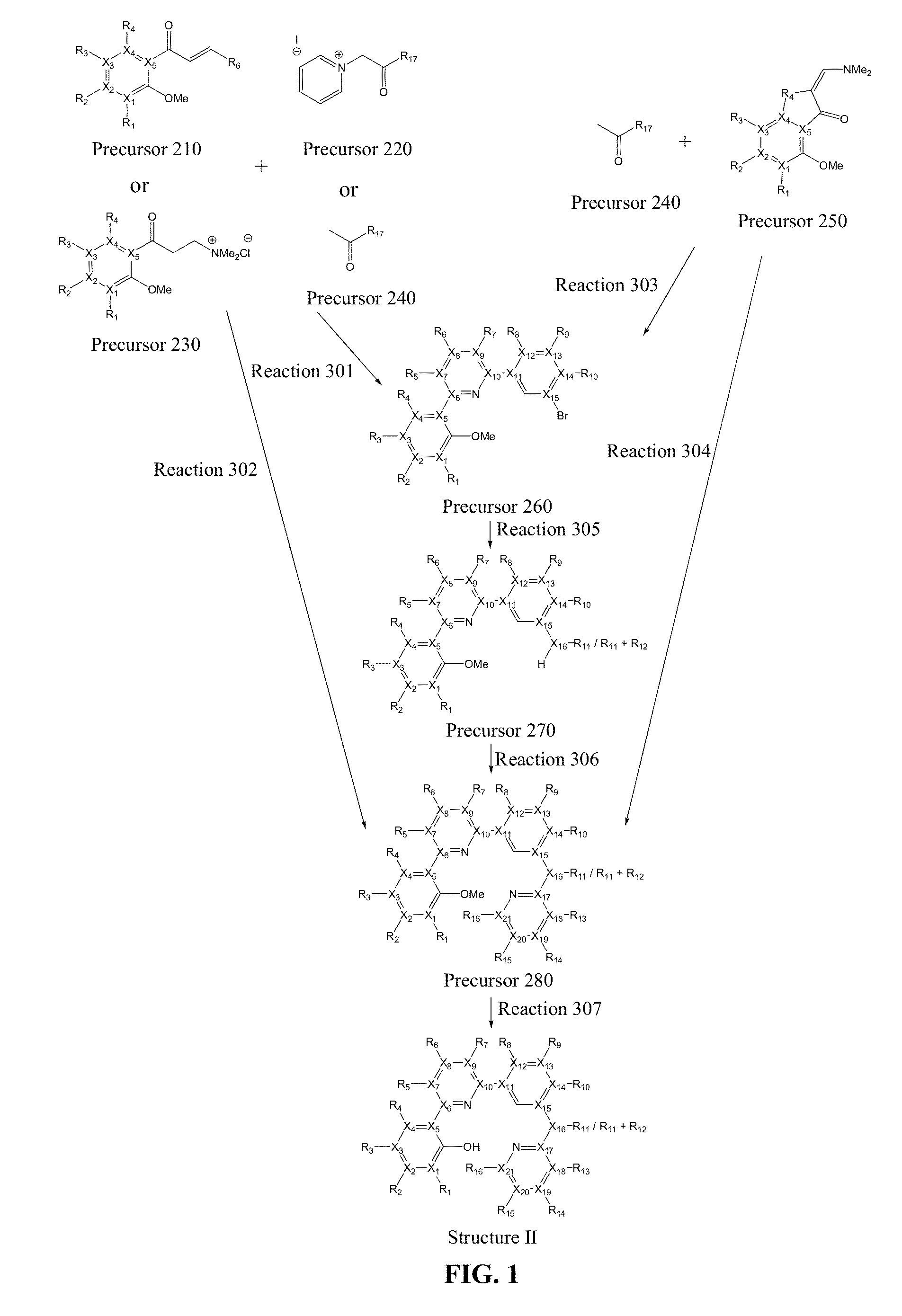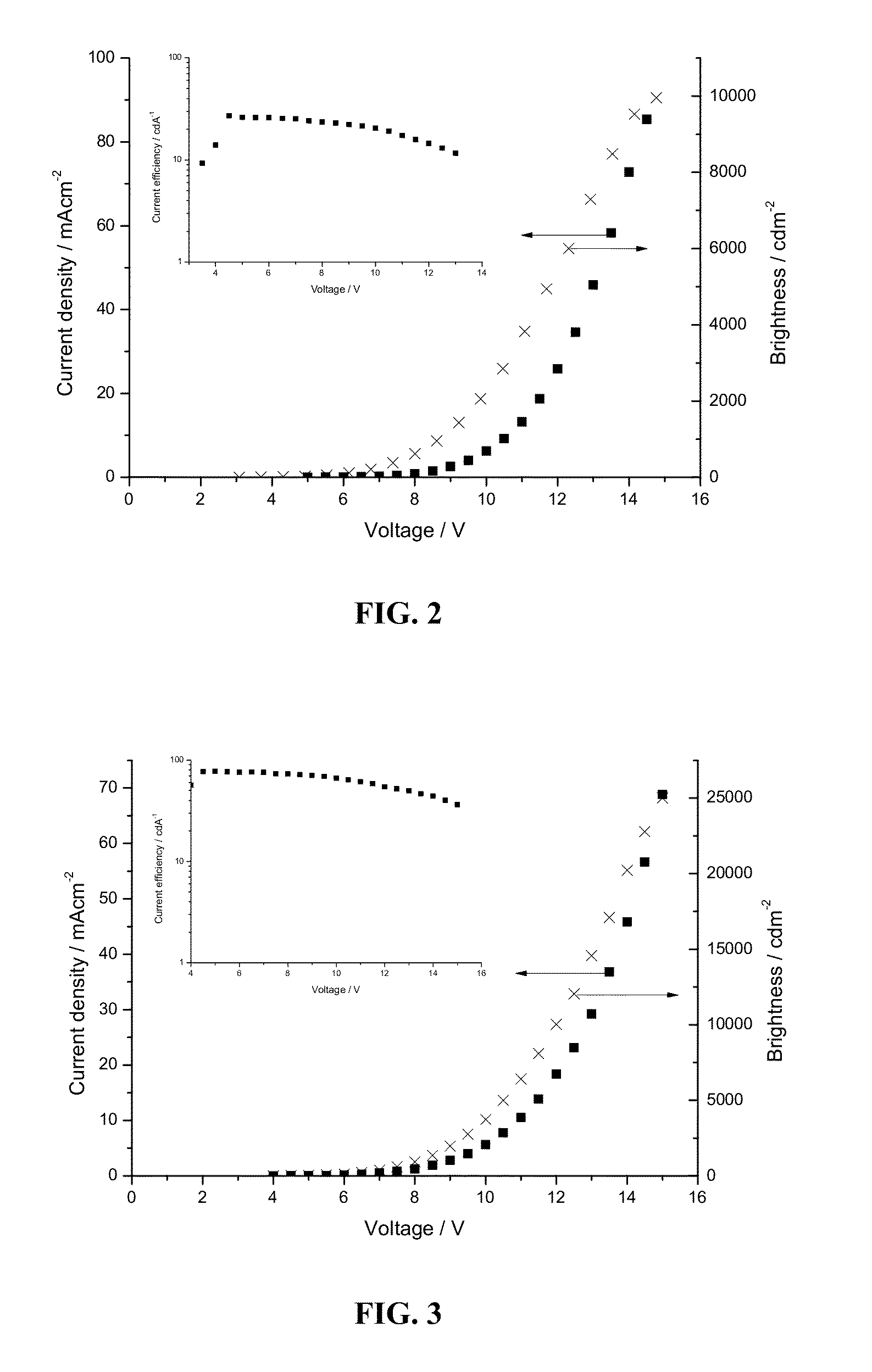Platinum(II) complexes for OLED applications
a technology of complexes and oleds, applied in the field of class platinum (ii) complexes, can solve the problems of high roll-off of most p-oleds, and achieve the effect of low roll-off and high efficiency
- Summary
- Abstract
- Description
- Claims
- Application Information
AI Technical Summary
Benefits of technology
Problems solved by technology
Method used
Image
Examples
example 1
Preparation of Precursor 261
[0083]
[0084]To a conical flask was charged with Precursor 221 (2.24 g, 5.5 mmol), Precursor 211 (1.95 g, 5.5 mmol), excess ammonium acetate, and methanol. The mixture was refluxed for 24 h. After cooling to room temperature, the solvent was evaporated. The crude mixture was extracted with dichloromethane and purified by chromatography on silica gel with mixture of hexane and ethyl acetate (v / v=10:1). 2.56 g of off-white solid was obtained. Yield: 88%. 1H NMR (CDCl3, 400 MHz): δ 8.31 (s, 1H), 8.05-8.04 (m, 2H), 8.01 (d, J=7.6 Hz, 1H), 7.78 (s, 1H), 7.55-7.53 (m, 2H), 7.52 (s, 2H), 7.42 (t, J=7.3 Hz, 1H), 7.36 (t, J=7.9 Hz, 1H), 7.15 (t, J=7.5 Hz, 1H), 7.05 (d, J=8.2 Hz, 1H), 3.90 (s, 3H), 1.41 (s, 18H).
example 2
Preparation of Precursor 271
[0085]
[0086]To a dry, nitrogen-flushed flask was charged with Precursor 261 (1.44 g, 2.7 mmol), potassium tert-butoxide (0.42 g, 3.8 mmol), Pd(dba)2 (0.25 g, 0.27 mmol), DPE-phos(bis[2-(diphenylphosphino)phenyl]ether) (0.29 g, 0.55 mmol), aniline (0.25 g, 2.7 mmol), and anhydrous toluene. The mixture was refluxed for 24 h. After cooling to room temperature, ethyl acetate was added, and the mixture was stirred for five minutes. The crude mixture was extracted with ethyl acetate and purified by chromatography on silica gel with mixture of hexane and ethyl acetate (v / v=10:1). 1.31 g of yellow solid was obtained. Yield: 90%. 1H NMR (CDCl3, 400 MHz): δ 8.03 (s, 2H), 7.88 (s, 1H), 7.79 (s, 1H), 7.62 (m, 1H), 7.53 (s, 3H), 7.42-7.39 (m, 2H), 7.38-7.36 (m, 1H), 7.30-7.28 (m, 2H), 7.13-7.11 (m, 2H), 7.05-7.03 (m, 2H), 6.93 (m, 1H), 5.86 (s, 1H), 3.89 (s, 3H), 1.40 (s, 18H).
example 3
Preparation of Precursor 281
[0087]
[0088]To a dry, nitrogen-flushed flask was charged with Precursor 271 (1.31 g, 2.4 mmol), potassium tert-butoxide (0.33 g, 2.9 mmol), Pd(dba)2 (0.22 g, 0.24 mmol), DPE-phos, 2-iodopyridine (0.26 g, 0.48 mmol), and anhydrous toluene. The mixture was refluxed for 24 h. After cooling to room temperature, ethyl acetate was added, and the mixture was stirred for five minutes. The crude mixture was extracted with ethyl acetate and purified by chromatography on silica gel with mixture of hexane and ethyl acetate (v / v=10:1). 1.29 g of yellow solid was obtained. Yield: 87%. 1H NMR (CDCl3, 400 MHz): δ 8.26 (d, J=4.92 Hz, 1H), 8.01 (s, 1H), 7.96 (d, J=7.6 Hz, 1H), 7.93-7.89 (m, 2H), 7.70 (s, 1H), 7.52 (t, J=1.97 Hz, 1H), 7.49 (s, 2H), 7.45-7.23 (m, 8H), 7.11 (q, J=7.5 Hz, 2H), 7.03 (d, J=8.2 Hz, 1H), 6.84 (d, J=8.4 Hz, 1H), 6.78-6.80 (m, 1H), 3.86 (s, 3H), 1.38 (s, 18H).
PUM
| Property | Measurement | Unit |
|---|---|---|
| emissive quantum efficiency | aaaaa | aaaaa |
| current efficiency | aaaaa | aaaaa |
| current efficiency | aaaaa | aaaaa |
Abstract
Description
Claims
Application Information
 Login to View More
Login to View More - R&D
- Intellectual Property
- Life Sciences
- Materials
- Tech Scout
- Unparalleled Data Quality
- Higher Quality Content
- 60% Fewer Hallucinations
Browse by: Latest US Patents, China's latest patents, Technical Efficacy Thesaurus, Application Domain, Technology Topic, Popular Technical Reports.
© 2025 PatSnap. All rights reserved.Legal|Privacy policy|Modern Slavery Act Transparency Statement|Sitemap|About US| Contact US: help@patsnap.com



